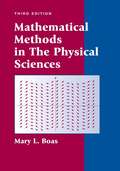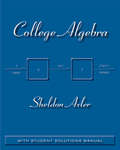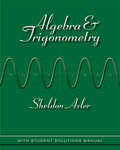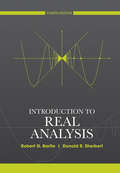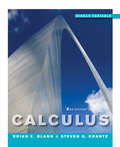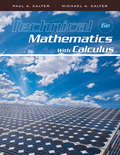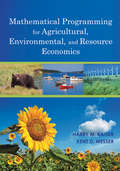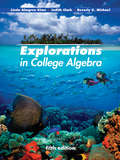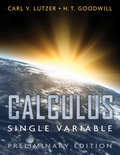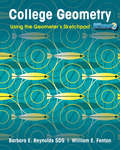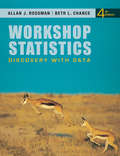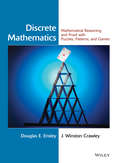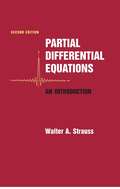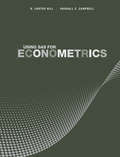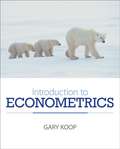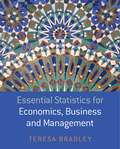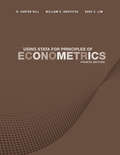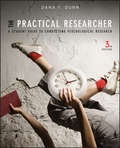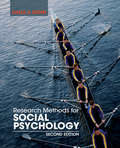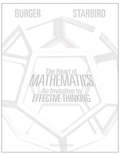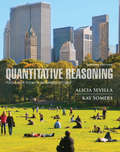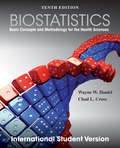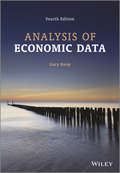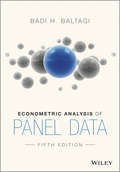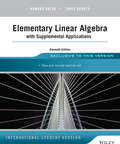- Table View
- List View
Mathematical Methods in the Physical Sciences
by Mary L. BoasNow in its third edition, Mathematical Concepts in the Physical Sciences, 3rd Edition provides a comprehensive introduction to the areas of mathematical physics. It combines all the essential math concepts into one compact, clearly written reference. This book is intended for students who have had a two-semester or three-semester introductory calculus course. Its purpose is to help students develop, in a short time, a basic competence in each of the many areas of mathematics needed in advanced courses in physics, chemistry, and engineering. Students are given sufficient depth to gain a solid foundation (this is not a recipe book). At the same time, they are not overwhelmed with detailed proofs that are more appropriate for students of mathematics. The emphasis is on mathematical methods rather than applications, but students are given some idea of how the methods will be used along with some simple applications.
College Algebra
by Sheldon AxlerCollege Algebra, First Edition will appeal to those who want to give important topics more in-depth, higher-level coverage. This text offers streamlined approach accompanied with accessible definitions across all chapters to allow for an easy-to-understand read. College Algebra contains prose that is precise, accurate, and easy to read, with straightforward definitions of even the topics that are typically most difficult for students.
Algebra and Trigonometry
by Sheldon AxlerAxler Algebra & Trigonometry is written for the two semester course. The text provides students with the skill and understanding needed for their coursework and for participating as an educated citizen in a complex society. Axler Algebra & Trigonometry focuses on depth, not breadth of topics by exploring necessary topics in greater detail. Readers will benefit from the straightforward definitions and plentiful examples of complex concepts. The Student Solutions Manual is integrated at the end of every section. The proximity of the solutions encourages students to go back and read the main text as they are working through the problems and exercises. The inclusion of the manual also saves students money. Axler Algebra & Trigonometry is available with WileyPLUS; an innovative, research-based, online environment for effective teaching and learning. WileyPLUS sold separately from text.
Introduction to Real Analysis
by Robert G. Bartle Donald R. SherbertThis text provides the fundamental concepts and techniques of real analysis for students in all of these areas. It helps one develop the ability to think deductively, analyze mathematical situations, and extend ideas to a new context. Like the first three editions, this edition maintains the same spirit and user-friendly approach with additional examples and expansion on Logical Operations and Set Theory. There is also content revision in the following areas: Introducing point-set topology before discussing continuity, including a more thorough discussion of limsup and limimf, covering series directly following sequences, adding coverage of Lebesgue Integral and the construction of the reals, and drawing student attention to possible applications wherever possible.
Calculus: Single Variable
by Brian E. Blank Steven G. KrantzIn order to show scientists and engineers how to apply calculus, this edition places a greater emphasis on conceptual understanding. It provides a nice balance between rigor and accessibility that will challenge them. Unique elements are integrated throughout that deepen the appreciation for calculus. Numerous nonstandard challenging exercises build better math skills. Innovative approaches on topics such as limits also help uncover new areas of learning for scientists and engineers.
Technical Mathematics with Calculus
by Paul A. Calter Michael A. CalterThis text is designed to provide a mathematically rigorous, comprehensive coverage of topics and applications, while still being accessible to students. Calter/Calter focuses on developing students' critical thinking skills as well as improving their proficiency in a broad range of technical math topics such as algebra, linear equations, functions, and integrals. Using abundant examples and graphics throughout the text, this edition provides several features to help students visualize problems and better understand the concepts. Calter/Calter has been praised for its real-life and engineering-oriented applications. The sixth edition of Technical Mathematics has added back in popular topics including statistics and line graphing in order to provide a comprehensive coverage of topics and applications--everything the technical student may need is included, with the emphasis always on clarity and practical applications.
Mathematical Programming for Agricultural, Environmental, and Resource Economics
by Harry M. Kaiser Kent D. MesserMathematical Programming for Agricultural, Environmental, and Resource Economics educates students on the techniques of mathematical programming and their application to agricultural, resource, and environmental economics problems. This text artfully combines an introductory text in math programming, algebraic and geometric concepts while also presenting differential calculus designed for upper-level undergraduates and graduate students. This text is designed specifically to help students develop the quantitative skills necessary for cutting edge research and techniques.
Explorations in College Algebra
by Linda Almgren Kime Judy Clark Beverly K. MichaelExplorations in College Algebra, 5/e and its accompanying ancillaries are designed to make algebra interesting and relevant to the student. The text adopts a problem-solving approach that motivates students to grasp abstract ideas by solving real-world problems. The problems lie on a continuum from basic algebraic drills to open-ended, non-routine questions. The focus is shifted from learning a set of discrete mathematical rules to exploring how algebra is used in the social, physical, and life sciences. The goal of Explorations in College Algebra, 5/e is to prepare students for future advanced mathematics or other quantitatively based courses, while encouraging them to appreciate and use the power of algebra in answering questions about the world around us. Explorations in College Algebra was developed by the College Algebra Consortium based at the University of Massachusetts, Boston and funded by a grant from the National Science Foundation. The materials were developed in the spirit of the reform movement and reflect the guidelines issued by the various professional mathematics societies (including AMATYC, MAA, and NCTM).
Calculus, Single Variable
by Carl V. Lutzer H. T. GoodwillStudents and math professors looking for a calculus resource that sparks curiosity and engages them will appreciate this new book. Through demonstration and exercises, it shows them how to read equations. It uses a blend of traditional and reform emphases to develop intuition. Narrative and exercises present calculus as a single, unified subject. Color is used to help them identify and interpret the parts of a mathematical model. In addition, formal proofs are preceded with informal discussions that focus on the ideas about to be presented. Then the proofs are discussed in a way that helps scientists and engineers interpret the details of the argument.
College Geometry: Using the Geometer's Sketchpad
by Barbara E. Reynolds William E. FentonFrom two authors who embrace technology in the classroom and value the role of collaborative learning comes College Geometry Using The Geometer's Sketchpad, a book that is ideal for geometry courses for both mathematics and math education majors. The book's truly discovery-based approach guides students to learn geometry through explorations of topics ranging from triangles and circles to transformational, taxicab, and hyperbolic geometries. In the process, students hone their understanding of geometry and their ability to write rigorous mathematical proofs.
Workshop Statistics: Discovery with Data
by Allan J. Rossman Beth L. ChanceAllan Rossman's 4th Edition of Workshop Statistics: Discovery with Data is enhanced from previous issues with more focus and emphasis on collaborative learning. It further requires student observation, and integrates technology for gathering, recording, and synthesizing data. The text offers more flexibility in selecting technology tools for classrooms primarily using technologies other than graphing calculators or Fathom Dynamic Data software. Furthermore, it presents more standards for teaching statistics in an innovative, investigative, and accessible as well as provides in-depth guidance and resources to support active learning of statistics and includes updated real data sets with everyday applications in order to promote statistical literacy.
Discrete Mathematics: Mathematical Reasoning and Proof with Puzzles, Patterns, and Games
by Douglas E. Ensley J. Winston CrawleyDid you know that games and puzzles have given birth to many of today's deepest mathematical subjects? Now, with Douglas Ensley and Winston Crawley's Introduction to Discrete Mathematics, you can explore mathematical writing, abstract structures, counting, discrete probability, and graph theory, through games, puzzles, patterns, magic tricks, and real-world problems. You will discover how new mathematical topics can be applied to everyday situations, learn how to work with proofs, and develop your problem-solving skills along the way. Online applications help improve your mathematical reasoning. Highly intriguing, interactive Flash-based applications illustrate key mathematical concepts and help you develop your ability to reason mathematically, solve problems, and work with proofs. Explore More icons in the text direct you to online activities at www.wiley.com/college/ensley. Improve your grade with the Student Solutions Manual. A supplementary Student Solutions Manual contains more detailed solutions to selected exercises in the text.
Partial Differential Equations: An Introduction, Enhanced ePub
by Walter A. StraussOur understanding of the fundamental processes of the natural world is based to a large extent on partial differential equations (PDEs). The second edition of Partial Differential Equations provides an introduction to the basic properties of PDEs and the ideas and techniques that have proven useful in analyzing them. It provides the student a broad perspective on the subject, illustrates the incredibly rich variety of phenomena encompassed by it, and imparts a working knowledge of the most important techniques of analysis of the solutions of the equations. In this book mathematical jargon is minimized. Our focus is on the three most classical PDEs: the wave, heat and Laplace equations. Advanced concepts are introduced frequently but with the least possible technicalities. The book is flexibly designed for juniors, seniors or beginning graduate students in science, engineering or mathematics.
Using SAS for Econometrics
by R. Carter Hill Randall C. CampbellA supplement such as Using SAS for Econometrics is quite essential for use in a classroom environment, for those attempting to learn SAS, and for quick and useful reference. The SAS documentation comes in many volumes, and several are thousands of pages long. This makes for a very difficult challenge when getting started with SAS. This volume spans several levels of econometrics. It is suitable for undergraduate students who will use canned SAS statistical procedures, and for graduate students who will use advanced procedures as well as direct programming in SAS's matrix language, discussed in chapter appendices. Material within the chapters is accessible to undergraduate and/or Masters students, with appendices to chapters devoted to more advanced materials and matrix programming.
Introduction to Econometrics
by Gary KoopIntroduction to Econometrics has been written as a core textbook for a first course in econometrics taken by undergraduate or graduate students. It is intended for students taking a single course in econometrics with a view towards doing practical data work. It will also be highly useful for students interested in understanding the basics of econometric theory with a view towards future study of advanced econometrics. To achieve this end, it has a practical emphasis, showing how a wide variety of models can be used with the types of data sets commonly used by economists. However, it also has enough discussion of the underlying econometric theory to give the student a knowledge of the statistical tools used in advanced econometrics courses. Key Features: * A non-technical summary of the basic tools of econometrics is given in chapters 1 and 2, which allows the reader to quickly start empirical work. * The foundation offered in the first two chapters makes the theoretical econometric material, which begins in chapter 3, more accessible. * Provides a good balance between econometric theory and empirical applications. * Discusses a wide range of models used by applied economists including many variants of the regression model (with extensions for panel data), time series models (including a discussion of unit roots and cointegration) and qualitative choice models (probit and logit). An extensive collection of web-based supplementary materials is provided for this title, including: data sets, problem sheets with worked through answers, empirical projects, sample exercises with answers, and slides for lecturers. URL: www.wileyeurope.com/college/koop
Essential Statistics for Economics, Business and Management
by Teresa BradleyEssential Statistics for Economics, Business and Management assumes no prior knowledge of statistics. It will also be highly relevant for the statistics component of courses in quantitative methods. The style of the book is similar to that of the highly successful Essential Mathematics for Economics and Business by Teresa Bradley and Paul Patton, with many worked examples integrated throughout. Emphasis is placed on verbalising concepts, problems and results of statistical analysis. This will help students learn how to start a problem, complete the calculations, and report the results in a way that makes sense to a non-statistician. Each concept is introduced with a brief but plausible explanation followed by Worked Examples. The Worked Examples will provide students with the necessary practice that they need in order to succeed at the subject. Emphasis is also placed on ?learning through doing? problems. Excel is used to encourage students in doing problems and to enhance understanding (with links to datasets online). Minitab printouts are also included in the text. Skills Development Exercises with brief solutions are included within the chapters, and Progress Exercises on theory and applications are provided at the end of each chapter. Solutions to all the worked examples and progress exercises are available as an appendix. Web-based supplementary materials will be provided for lecturers adopting the text, including additonal exercises and solutions, excel datasets and exercises, powerpoint slides with key formula, figures and tables. Students can access an online glossary and weblinks.
Using Stata for Principles of Econometrics
by Lee C. Adkins R. Carter HillThis is the Using Stata text for Principles of Econometrics, 4th Edition.Principles of Econometrics is an introductory book for undergraduate students in economics and finance, and can be used for MBA and first-year graduate students in many fields. The 4th Edition provides students with an understanding of why econometrics is necessary and a working knowledge of basic econometric tools. This text emphasizes motivation, understanding and implementation by introducing very simple economic models and asking economic questions that students can answer.
The Practical Researcher: A Student Guide to Conducting Psychological Research
by Dana S. DunnIn The Practical Researcher, Dana S. Dunn’s student-friendly writing style and personal tone provide readers with a practical and engaging introduction to research methods in psychology. Using basic theory, solid research practices, and step-by-step techniques, the author leads students through the process of conducting a project from start to finish. The importance of learning to search, read, and critique the psychological literature, as well as writing clearly about it, are emphasized throughout. Boxed features called “Research Foundations” present key issues faced by researchers, allowing students to ponder various controversies, while numerous examples, practical tips, and applied material bring the process of doing research to life. Packed with useful decision trees, tables, checklists, and illustrations, this clear and precise book will equip students with the tools they need to carry out their research successfully.
Research Methods for Social Psychology
by Dana S. DunnThe 2nd edition of Research Methods for Social Psychology offers information on how to conduct empirical research in social psychology. The author teaches readers to think like experimental social psychologists, that is, to use or develop explanatory theories and to manipulate and measure variables in order to explain the origin or purpose of some aspect of social life. It provides information to perform research projects on human social behavior from start to finish, from selecting a research topic to collecting and analyzing data to writing up and the results using the American Psychological Association’s required format (i.e., APA-style). Along the way, they will learn about the particular ethical issues social psychologists face, the logic of experimental design, alternative research approaches, sorting accuracy from error in research, and how to orally present their findings, among other issues. This book contains up-to-date scholarship and emphasizes active learning through pedagogical activities and exercises designed to help students design and execute their own social psychological research.
The Heart of Mathematics: An Invitation to Effective Thinking (Key Curriculum Press #137)
by Edward B. Burger Michael StarbirdTransform your mathematics course into an engaging and mind-opening experience for even your most math-phobic students. Now in its Fourth Edition, The Heart of Mathematics: An Invitation to Effective Thinking succeeds at reaching non-math, non-science-oriented majors, encouraging them to discover the mathematics inherent in the world around them. Infused with the authors’ humor and enthusiasm throughout, The Heart of Mathematics introduces students to the most important and interesting ideas in mathematics while inspiring them to actively engage in mathematical thinking.
Quantitative Reasoning: Tools for Today's Informed Citizen
by Alicia Sevilla Kay SomersThis Second Edition of Quantitative Reasoning empowers students to use quantitative information to make responsible financial, environmental, and health-related decisions in their daily lives. Students develop their critical thinking skills through numerous examples, explorations, and activities featuring real data. Students use a variety of analysis throughout the text: inductive and deductive reasoning; tabular, symbolic, verbal, and graphical forms of functions and relations; graphs and pictorial representations of data; interpretations of probabilistic data; surveys and statistical studies.
Biostatistics: Basic Concepts and Methodology for the Health Sciences, 10th Edition International Student Version (Wiley Series in Probability and Statistics)
by Wayne W. Daniel Chad L. CrossThis Tenth Edition of Biostatistics maintains its predecessors’ comprehensive approach to biostatistics as it is used in the biological sciences. Successfully utilized by both statisticians and practitioners, Biostatistics is an algebra-based text geared towards the advanced undergraduate and graduate student. This new edition has been revised to more closely align with the modern practice of biostatics, teaching methods, and technologies.
Analysis of Economic Data
by Gary KoopAnalysis of Economic Data has, over three editions, become firmly established as a successful textbook for students studying data analysis whose primary interest is not in econometrics, statistics or mathematics. It introduces students to basic econometric techniques and shows the reader how to apply these techniques in the context of real-world empirical problems. The book adopts a largely non-mathematical approach relying on verbal and graphical inuition and covers most of the tools used in modern econometrics research. It contains extensive use of real data examples and involves readers in hands-on computer work.
Econometric Analysis of Panel Data
by Badi H. BaltagiPanel data econometrics has evolved rapidly over the last decade. Micro and Macro panels are increasing in numbers and availability and methods to deal with these data are in high demand from practitioners. Written by one of the world's leading researchers and writers in the field, Econometric Analysis of Panel Data has become established as the leading textbook for postgraduate courses in panel data. This new edition has been fully revised and updated and includes: A new chapter entitled Spatial Panel Data New empirical applications New material on non-stationary panels. New empirical applications using Stata and EViews. Thoroughly updated References. Additional exercises in each chapter
Elementary Linear Algebra with Supplemental Applications: Applications Version
by Howard Anton Chris RorresElementary Linear Algebra 11th edition gives an elementary treatment of linear algebra that is suitable for a first course for undergraduate students. The aim is to present the fundamentals of linear algebra in the clearest possible way; pedagogy is the main consideration. Calculus is not a prerequisite, but there are clearly labeled exercises and examples (which can be omitted without loss of continuity) for students who have studied calculus.
